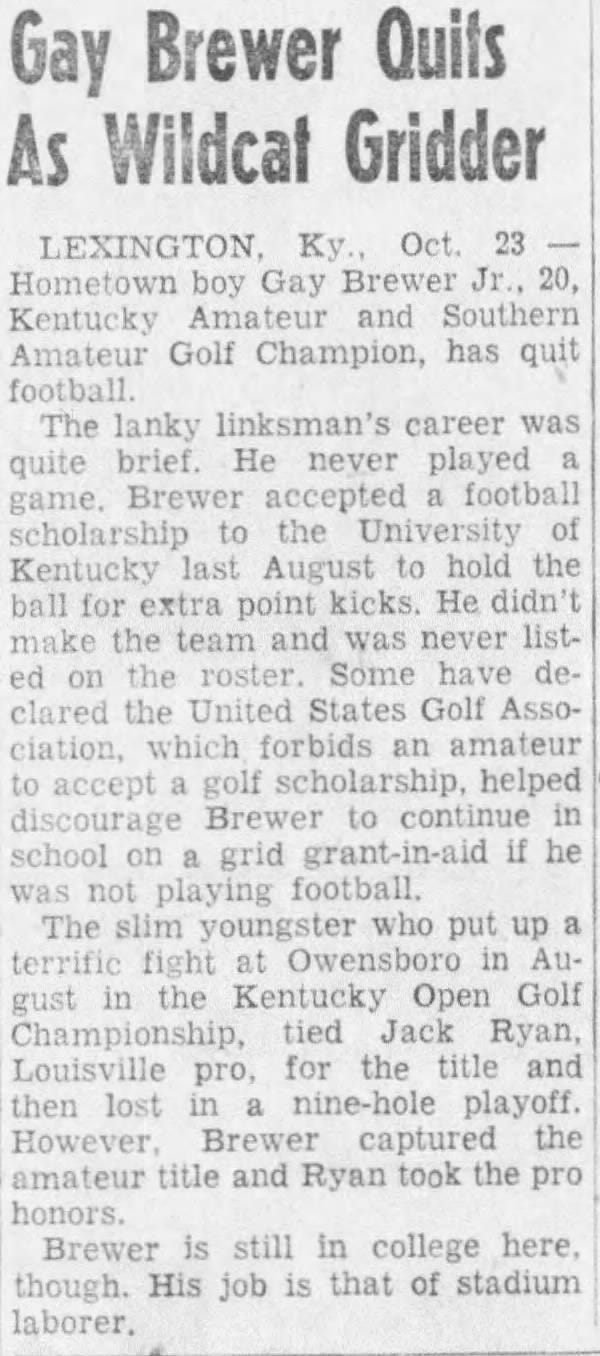Quick 9: Wink-Wink-Nudge-Nudge
I tend to write too much. Overstuffing each sentence with dashes, parenthesis, and asides. I know I do this, but I can't stop. There's just too much to tell. As far as indulgences go, it's pretty tame, but I need to quit.
As a way to do that I’m going to be putting these rabbit hole tidbits into a series that will be as deliberately to-the-point as I can make them. Some you’ve heard before, maybe even from me in an earlier post. Hopefully even the previously known will still be interesting, like a hole on a familiar golf course.
Won’t you join me for a quick 9?
*NOTE: underlined text provides a link to references or sites with more information
1. Proselyting
The NCAA was created in 1906 in part to give structure to each of the athletic events they sponsored as well as determine what was permissible in terms of recruiting athletes to schools. To that end, they defined a very interesting word: Proselyting. The clipping below explains in greater detail, but the point was to preserve the spirit of sports amateurism.
**I don’t know why but proselyting is one of those words that I find difficult to pronounce. I keep wanting to say “proselytizing” because for some reason having the extra syllables helps me. In any case, if you have any difficulty like me, it’s pronounced: PRAH-suh-lighting
2. The First Golf Scholarship?
Rules around this concept fluctuated over the decades, but offering scholarships was one inducement that was almost always allowed, even when it was heavily restricted. As more programs added golf as an official sport in the 1920s and 1930s, the concept of a golf scholarship finally materialized.
Although the first person to receive a golf-specific scholarship isn’t known with absolute certainty, it’s generally believed that it might have been Fred Haas (Jr). Haas tore up the golf scene in his native state of Arkansas even as a junior, and secured a promise of a scholarship to the University of Arkansas. Before he graduated from high school, however, his family moved to Louisiana where he came to the attention of “colorful” Governor Huey Long who convinced him to instead take a scholarship to play at LSU starting in 1933. That certainly worked out for both of them.
3. USGA Outdoes the NCAA
Colleges saw an influx of new and returning students following WWII. While colleges and universities became more lax on many things such as financial aid considerations, the NCAA passed a strict rule known as the “Sanity Code” in 1948 which sought to prevent athletes from receiving scholarships just on the stipulation of their play. The USGA took the concept one step further for golf and added a “Proselyting” entry to their rulebook which stated that any golfer attending a school on a scholarship that wasn’t tied to financial need would be stripped of their amateur status. The exceptions? Winning a scholarship as a prize or getting a “caddy scholarship” such as those given out by the (Chick) Evans Scholarship Foundation.
4. USGA Rule Won’t Effect College Stars…Right?
The USGA had a loud bark and a pretty mean bite, but they didn’t really have a way to get out of the yard and go investigate supposed infractions. Instead, they really waited until people made it too painfully obvious what was going on, and even then they seem to have tried to nudge rather than bite. At least at first. After all, it wasn’t really expected that this would affect many players or schools anyway.
5. Nope, We’re Definitely Not Giving Scholarships, We Promise
So here’s where the winking and nudging comes in. Golfers had just as much right to financial scholarships as any other student, so as long as they could demonstrate that need then it became pretty hard to prove a scholarship was just for golf. There are plenty of examples of newspapers discussing [star local golfer] currently does or is soon to attend [major state university] on “a golf scholarship,” but when pressed I’m sure the USGA would find that the golfer in question was actually receiving a “regular” financial scholarship. Take for example the case of Gardiner Dickinson (Jr) of LSU. First, note the quote from his coach in the June 1948 newspaper clipping above, then read this clipping from July 1949:
6. I’m a Football Player Now!
In 1952, Kentucky football coach Paul “Bear” Bryant landed a rather unusual recruit: his new “extra-point player” was golf recruit Gay Brewer. Apparently the USGA sniffed out what Kentucky was trying to do with giving Brewer a football scholarship so he never actually played a game. Instead he got hooked up with a cushy stadium job which helped offset his tuition cost.
7. North Texas State Gets Bit
Ok I’m cheating a bit here and making this one of those par 3s that you hit onto an island green. If you want to get your ball wet and go swimming, take a deep dive into this previous article.
Here’s the tee shot: the 1953 North Texas State team was on their way towards a five-peat when they suddenly got hit with USGA sanctions, resulting in all of the starting players getting their amateur statuses revoked. After a short back and forth, and perhaps with a little intervening from Byron Nelson, most of the players were reinstated before the NCAA championship, but the damage had been done. Even years later, NTSC player turned pro Don January was still pissed and didn’t mince words on the subject. He apparently wasn’t the only one riled up.
8. Common Sense Proselyting
I don’t yet know the exact time when golf scholarships became officially accepted and limited by the NCAA, but we do know that the organization largely dropped the Sanity Rule across the board in 1951 when it became clearly untenable. The USGA held steadfast until 1953 when it amended its language to say that Proselyting was:
Because of golf skill or golf reputation, accepting any consideration as an inducement to be a student in an educational institution. However, a student may accept a scholarship approved by a regular authority of the institution awarding all scholarships.
As we’ve seen from the quotes above from 1956, this still put a limiter on providing actual golf scholarships (wink-wink-nudge-nudge) and wasn’t popular. It wasn’t until the mid 1960s that the language in the rulebook was amended to define Proselyting as a scholarship or financial inducements coming from anyplace other than the school and could not be “…in excess of commonly accepted educational expenses as defined by the National Collegiate Athletic Association.” The word was dropped altogether in 1968.
9. Everyone Gets a Scholarship Now?
Today, golf scholarships are as ubiquitous as scholarships in any other sport, although that may soon change. A recent Yahoo news article indicated that the NCAA plans to increase scholarships and roster limits for sports including football and baseball, but what does that mean for golf? We’ve definitely seen this movie before, where a ballooning in athletic budget spending resulted in “non-revenue sports” such as golf getting the ax. Combine the anticipated cost increase with Title IX considerations, and you can see why some are concerned golf may be more likely to go to zero scholarships at “smaller” schools rather than the anticipated 9 for each of the men’s and women’s teams at each school.
Thanks for reading! I’m going to hit the back 9 on this topic next week. I felt like I had to properly introduce what was going on here, but there are just so many interesting stories from the 1950s-1960s involving (alleged) golf scholarships that we have to keep playing this course.











Great newsletter. Love this snappy bite-sized format supported by your extensive research!